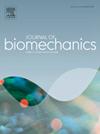经膝截肢者与经股截肢者和健全对照者在行走过程中的下肢运动学和动力学
IF 2.4
3区 医学
Q3 BIOPHYSICS
引用次数: 0
摘要
下肢截肢会对生活质量产生负面影响,并增加继发性健康状况的风险。通过膝关节截肢(TKA)虽然不如经股截肢(TFA)常见,但由于保留了股骨长度和相关肌肉组织,因此具有潜在的生物力学优势。本研究旨在描述单侧TKA、TFA和健全对照患者的步态生物力学特征。采用三维运动跟踪系统和力板对7例单侧TFA患者、4例单侧TKA患者和9例健全对照者的步态生物力学进行了评估。计算并比较各组之间踝关节、膝关节、髋关节和骨盆的关节角度和力矩。与TFA患者相比,TKA患者的行走机制与健全人对照组的差异较小。TKA患者截肢侧髋关节活动度(ROM)大于TFA患者,分别为52.71°±7.3°和40.38°±5.4°,p <;0.005)。与对照组相比,TFA患者骨盆前/后倾斜ROM更高(分别为11.26°±7.2°和3.1°±1.5°),p <;0.005),但TKA与对照组间差异无统计学意义。与TFA组相比,TKA组和健全对照组完整侧髋关节伸展力矩峰值均较低(1.05(±0.43)、1.05(±0.39)和1.83(±0.28)N.m.kg−1,p <;0.005, p <;0.05分别)。这些研究结果表明,TKA可能比TFA具有生物力学优势,特别是在保持步态生物力学更接近健全对照方面,强调了该手术对需要下肢截肢的个体的潜在优势。本文章由计算机程序翻译,如有差异,请以英文原文为准。
Lower limb kinematics and kinetics of people with through-knee amputation compared to individuals with transfemoral amputation and able-bodied controls during walking
Lower-limb amputations negatively affect quality of life and increase the risk of secondary health conditions. Through-Knee Amputation (TKA), although less commonly performed than Transfemoral Amputation (TFA), offers potential biomechanical advantages due to preserved femur length and associated musculature. This study aimed to characterize gait biomechanics of individuals with unilateral TKA, TFA and able-bodied controls. Gait biomechanics of seven individuals with unilateral TFA, four with unilateral TKA, and nine able-bodied controls were evaluated with a 3D motion tracking system and force plates. Joint angles and moments at the ankle, knee, hip, and pelvis were computed and compared between groups. Individuals with TKA’s walking mechanics displayed fewer differences with able bodied controls compared to individuals with TFA. Individuals with TKA had greater hip Range Of Motion (ROM) on the amputated side than TFA (52.71° ± 7.3°, 40.38° ± 5.4° respectively, p < 0.005). TFA individuals had higher pelvic antero/posterior tilt ROM compared to controls (11.26° ± 7.2° and 3.1° ± 1.5° respectively, p < 0.005) but TKA and controls were not statistically different from each other. TKA individuals and able-bodied controls both had lower peak hip extension moments on the intact side than individuals with TFA (1.05 (±0.43), 1.05 (±0.39) and 1.83 (±0.28) N.m.kg−1, p < 0.005, p < 0.05 respectively). These findings suggest that TKA may offer biomechanical advantages over TFA, particularly in preserving gait biomechanics closer to able-bodied controls, underscoring the potential advantages of this procedure for individuals requiring lower-limb amputation.
求助全文
通过发布文献求助,成功后即可免费获取论文全文。
去求助
来源期刊

Journal of biomechanics
生物-工程:生物医学
CiteScore
5.10
自引率
4.20%
发文量
345
审稿时长
1 months
期刊介绍:
The Journal of Biomechanics publishes reports of original and substantial findings using the principles of mechanics to explore biological problems. Analytical, as well as experimental papers may be submitted, and the journal accepts original articles, surveys and perspective articles (usually by Editorial invitation only), book reviews and letters to the Editor. The criteria for acceptance of manuscripts include excellence, novelty, significance, clarity, conciseness and interest to the readership.
Papers published in the journal may cover a wide range of topics in biomechanics, including, but not limited to:
-Fundamental Topics - Biomechanics of the musculoskeletal, cardiovascular, and respiratory systems, mechanics of hard and soft tissues, biofluid mechanics, mechanics of prostheses and implant-tissue interfaces, mechanics of cells.
-Cardiovascular and Respiratory Biomechanics - Mechanics of blood-flow, air-flow, mechanics of the soft tissues, flow-tissue or flow-prosthesis interactions.
-Cell Biomechanics - Biomechanic analyses of cells, membranes and sub-cellular structures; the relationship of the mechanical environment to cell and tissue response.
-Dental Biomechanics - Design and analysis of dental tissues and prostheses, mechanics of chewing.
-Functional Tissue Engineering - The role of biomechanical factors in engineered tissue replacements and regenerative medicine.
-Injury Biomechanics - Mechanics of impact and trauma, dynamics of man-machine interaction.
-Molecular Biomechanics - Mechanical analyses of biomolecules.
-Orthopedic Biomechanics - Mechanics of fracture and fracture fixation, mechanics of implants and implant fixation, mechanics of bones and joints, wear of natural and artificial joints.
-Rehabilitation Biomechanics - Analyses of gait, mechanics of prosthetics and orthotics.
-Sports Biomechanics - Mechanical analyses of sports performance.
 求助内容:
求助内容: 应助结果提醒方式:
应助结果提醒方式:


